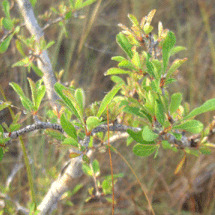Shrubs or trees, to 10 m. Stems armed, villous, glabrescent. Leaves deciduous; petiole 1-6.5 mm, glabrous; blade (dark green adaxially), broadly elliptic, obovate, oblanceolate, or spatulate, 6-38 × 3-23 mm, base attenuate to cuneate, margins plane, apex rounded to obtuse, surfaces glabrous, tertiary and smaller veins not prominent (inconspicuously reticulate), midrib flat, marginal vein present. Inflorescences 4-12-flowered. Pedicels 3-6 mm, glabrous. Flowers: calyx 1.8-3 mm diam.; sepals 5, 1.7-3 × 0.9-1.9 mm, glabrous; petals 5(-6), white to yellowish, median segment elliptic, 1.9-2.3 mm, lateral segments lanceolate, 1.3-2.3 mm; stamens 5(-6), 2.2-2.9 mm; staminodes lanceolate, 1.7-2.1 mm, minutely erose; anthers lanceolate, 0.7-1 mm; pistil 5-carpellate; ovary 5-locular, 0.9-1.3 mm, hirsute to strigose basally; style 2.2-2.8 mm. Berries purple to purplish black, ellipsoid, 8-12 mm, glabrous. Seeds 6-11 mm.
More
A dense shrub or small tree. It can be 12 m high with a trunk 30 cm across. The bark is dark grey to black. The young branches have soft white hairs. There are often stout spines present. The leaves are arranged in spirals at first. They later form tufts. The leaves are 0.7-5 cm long by 0.3-2.5 cm wide. There are 5-8 pairs of secondary veins. The leaf stalk is 0.5-4 mm long. The flowers have both sexes. There are 2-5 or more flowers in a group. The fruit are 0.9-1.5 cm long. They are narrow and oval. The mature fruit is purple or black. There is one seed 0.7-1.3 cm long. The seed coat is hard and shiny. The fruit are edible.


